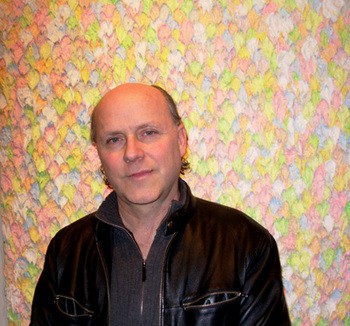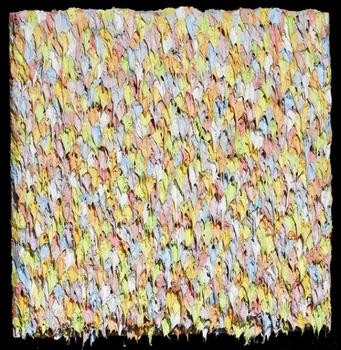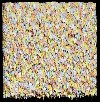Artist Martin Mugar: Beer and Burgers
Delectable Polka Dot Surfaces
By: Charles Giuliano - Sep 17, 2013
Martin Mugar: Paintings
McCoy Gallery
Merrimack College
315 Turnpike Street
North Andover, Mass
Through October 12, 2005
Over the years, some of my Beer and Burger meetings with artist Martin Mugar have been epic. Early on, when we first met, there was a hilarious gonzo evening, with copious vino, at the elegant Algonquin Club, a bastion of the old Boston. We closed the dining room as the last guests and were still lingering over coffee when the maitre d’ deftly lured us to the lounge with complimentary snifters of brandy. After which I suggested a nightcap at the Pour House a lively pub on Boylston Street. In every sense our more recent meetings have been more temperate but no less animated. We may have lost a step or two in the realm of ribaldry, time does make cowards of us all, but if anything the dialogue has grown more incisive. The wits sharpen as the other aspects atrophy.
There was a delightful evening on the deck of our Adams home this past summer. Martin had just completed a week of teaching at the summer camp of Art New England in Bennington, Vermont. I suggested that he break up the return to New Hampshire with a night in our loft in North Adams. There he installed a small but dense painting. It takes some skill and special handling because of the unique surface that is thickly worked with an impasto of oil paint blended with wax. It looks terrific in that vast space so the evening was a celebration of acquisition and friendship shared with Astrid and our soon to be loft neighbors Robert and Rachel Rendo. The evening was full of talk of Paris where Martin has lived as has Rachel. Martin met his wife Alix,an artist and musician when they were students at L' Ecole des Beaux-Arts. She was born in Morocco and grew up in Montreal before the family relocated to France. So there were stories of favorite bistros and places to get small but amazing scoops of ice cream.
Which is much the response that the paintings evoke. When Astrid first encountered his work in a group show that I curated she remarked that she found them delicious and expressed a desire to lick the candy colored, pastel surfaces. Viewers have to be restrained from the urge to reach out and touch them. We devour the paintings as our eyes eat them in greedy erotic gulps of pure pleasure.
Our dialogues have often focused on his years at Yale as an undergraduate and graduate student. The other day over pizza at Santarpio’s in East Boston we were discussing the impact of our education and the notion that at times what we teach or learn doesn’t sink in until years later. He recalled a studio visit at Yale with Al Held who could be quite didactic. He was making an emphatic point which at the time Martin was not prepared to absorb. Held was suggesting that the work had a number of influences to sort out. Rather sharply Martin told the professor, “Yeah Al, and right now you are one too many.” Held left abruptly but Martin conveyed to me that it was only many years later that what he had been trying to say made sense.
It was just the kind of anecdote that I have so enjoyed sharing. Actually Martin is one of my more thoughtful and thought provoking artist friends. And one of the most dedicated and obsessed. Some years ago he stopped teaching full time and with carefully managed resources has been able to paint full time. Largely in isolation. Far from the maddening crowd and entirely to satisfy himself. So there is a passion and purity to the work. Rather like Cezanne in the solitary confinement of his studio in Aix en Provence. Cezanne is one of Martin’s inspirations and role models. There is the commonality of where to go from the divisionism of impressionism. Where Cezanne brought volume and structure as well as distortions of perspective, Martin seeks an intensity and mass to the eye candy of color assimilation. “It has taken me years to begin to understand Cezanne,” he said between bites of slices of mushroom and anchovies.
“My former student Joya Santarpio works here,” I said to Martin as I informed him that this is Boston’s best pizza joint and a favorite of my broker, Russ Jacobsen, who always orders it well done with extra cheese, garlic and sausage. When we were leaving I gave Joya a hug. She had been in the kitchen.
It had been five years since Martin’s last one man show at the former Creiger Dane Gallery on Newbury Street. Back in the day she was Boston’s most colorful, big hearted, hilarious and adventurous dealer. She took chances on artists and is accordingly greatly missed.
On this day we drove to the McCoy Gallery of Merrimack College a private Catholic institution in suburban Andover. The gallery is large but filled with too much natural light from an enormous skylight. It leaves an area of distracting bright light on the floor. Not the best design for fragile works of art. It would work better if a large scrim was used to soften the direct illumination. It is so annoying to me that people who know nothing about the needs of exhibitions are in charge of designing spaces. But on the positive side natural light was definitely an enhancement in viewing this work in which surface and color, the subtleties of visual perception are key to their appreciation and understanding.
The challenge of the work is that the incremental differences between individual works are sublime in the details. It is difficult to sense the growth and progress of the work which represented efforts of the past year and a half. Just which were the newest works and in what direction are they headed. Martin insists it is in the pull. The stroke that allows the thick paint to obey gravity and create a downward pyramid of color. We examined closely the incremental values of colors next to each other and how there was a pattern, implied or not, an underlying grid or how these stronger accents were embedded or provided a structure to passages of softer more whitened color. Overall it was a stunning and triumphant exhibition. What follows below is the catalogue essay I contributed to this occasion.
Pulled Dots: The Non Objective Paintings of Martin Mugar
For the past five years Martin Mugar has been working on a series that combines thick paint, sculptural surfaces, and pixelated patterns of premixed colors. Is there a title for the series? “Not really,” he responded but an evocative term “pulled dots” emerged. Thick strokes of individual colors, in complex patterns, are applied then pulled away allowing gravity to form triangular, downward pointing wedges.
“The series evolved through self reflection,” he explained. “It starts with the notion that all visual perception is about observing something. Gradually, I found myself observing the act of observation without reference to an external object.”
This was precisely how the abstract art of early modernism developed. Artists started by observing nature which they abstracted. That notion climaxed when the German-American artist, Hans Hoffmann, suggested to Jackson Pollock that he “observe nature.” Pollock famously responded “I am nature.”
“Yes, this work is a reexamination of that historical process from nature to non objective abstraction,” Mugar stated. “If you look at my work from 2000-2005 there have been subtle but significant changes. The number of premixed colors has increased from four to ten. They include: Red, green, two yellows, orange, purple, blue, white, and most recently, beige and gray, to ground and focus the patterns. So the works are more complex. Also, there is more control of the brushstroke.”
The changes in the work reflect more order in his life compared to a lot of turmoil and conflict in the 1990s. There is a meditative, narrowly focused, obsessive approach to painting. With few external distractions he is in the studio full time.
Because of the prominent use of “pulled dots” there are references to modern art from the Impressionism of Monet, the Pointillism of Seurat, to the visual sizzle of Op Art in the 1960s. Mugar’s recent abstract work relates to Post Modernism. But the development of the work, while informed by these references, has followed a more personal trajectory.
“While a student at Yale I took a course in Chinese calligraphy,” he explained. “It fascinated me that an individual might be a dissolute drunk and reprobate but a great calligrapher; because calligraphy is an exact reflection of the individual. In Chinese dragon scrolls it intrigued me that you never saw the entire mythical creature. Just bits and pieces. There was a sense of mystery. It was not all spelled out as in Western Art from Raphael to Mondrian. It is that sense of ephemeral wonderment that I strive for. I go into the studio each day to clarify who I am. There is a sense of self discovery and the outside world dissolves. It becomes me and my work with few distractions to clutter that experience.”
Reposted from Maverick Arts, September 24, 2005




